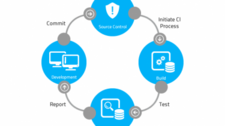Upgrade & Secure Your Future with DevOps, SRE, DevSecOps, MLOps!
We spend hours on Instagram and YouTube and waste money on coffee and fast food, but won’t spend 30 minutes a day learning skills to boost our careers.
Master in DevOps, SRE, DevSecOps & MLOps!
Learn from Guru Rajesh Kumar and double your salary in just one year.
Source:- wisdomjobs.com
What are the best practices of Continuou Integration?
Some of the best practices of Continuous Integration are:
Maintain a code repository
This is the basic step. Right from the code base to publish profiles to database scripts, everything is maintained in a Git repository. It is suggested that always ensure that everything is kept in the code repository.
Automate the build
A key step in the process of Continuous Integration is to automate a build by using MS Build along with publish profile.
Make the build self-testing
By maintaining the unit test case in place, a build can be tested. The test cases are placed in such a way that the Continuous Integration server can run it.
Everyone commits to the baseline every day
One of the key principles of Continuous Integration is to commit to the baseline every day, without staying till the end of the entire process to observe who breaks the build.
Every commit (to baseline) should be built
The commit made to a application has to be built successfully. For whatever reason, if the built fails, change the code such that the build passes.
Keep the build fast
The slow build indicates problem in the process of Continuous Integration. It is to be ensured that builds are limited to duration, preferably not beyond 10 minutes.
Everyone can see the results of the latest build
A view of all the builds, either passed or failed is made available to all by the TeamCity dashboard. This facilitates all the people involved in the Continuous Integration process, a good insight.
